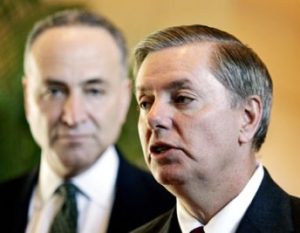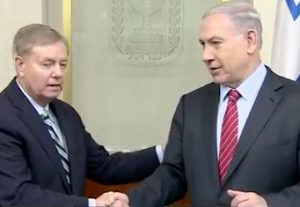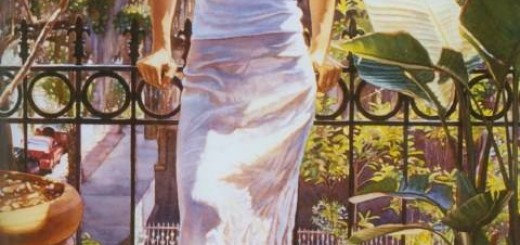TIMELINE OF JEWS IN AMERICA

NOTE 2016: Lindsey Graham (R-SC) = Announces his PLAN for an “All-Jewish Cabinet” to insure he raise lots of campaign funds to run for President in an interview published today on “Washington Wire,” a Wall Street Journal blog. “The means. If I put together a finance team that will make me financially competitive enough to stay in this thing… I may have the first all-Jewish cabinet in America because of the pro-Israel funding.”

Sen. Lindsey Graham (R-S.C.) spends a lot of time in Jewish company. Graham said of his contemplating a presidential run, but “Bottom Line is, I’ve got a lot of support from the pro-Israel funding.”
So we have to assume “pro-Israel funding” would determine his choice of cabinet secretaries, as well as his policies.
GRAHAM = CONSIDERING BEING A DEMOCRAT WHICH PROVES BOTH PARTIES ARE SOLD OUT TO (AIPAC) THE ZIO-NAZI ROTHSCHILDS MAFIA CRIME SYNDICATE CANCER THAT INFECTS AMERICA AND FAKES OUR MASS MURDERING BANKRUPTING $TRILLIONS IN WARS AND ROBBERY OF PENTAGON OF $15 TRILLION SINCE YEAR 2000!
GRAHAM LIKE A MIDDLE AGE SOUTHERN WOMAN SAYS LORDY MERCY LORDY MERCY THE WORLD IS ENDING!
JOHN STEWART ON GRAHAM: OH LORDY LORDY! ISIS(L) IS COMING TO AMERICA — WE WILL ALL BE KILT! SADDAM IS COMING — WE WILL ALL BE KILT!
If blocked click here: https://drive.google.com/open?id=0B9abPY8LcYR-ZDdDbVlMX2NfTXc
1695 Earliest record of a Jew in Charleston, SC and he acted as interpreter for Governor John Archdale.
1702 Jews appeared in numbers and voted at a general election. The early Jewish communities in the South were made up primarily of Sephardic Jews who had immigrated from London and the Netherlands, where they had settled following expulsion from Spain and Portugal in the late 15th century.
1740-1741 The Jewish community at Charleston grew substantially following a Spanish invasion of Georgia in 1733.
Mid-1700s, Charleston was the preferred destination of Jewish immigrants from London, who represented numerous wealthy merchant families. They became involved in business, trade, finance and agriculture in Charleston, with some owning plantations.
1800 2,000 Jews in South Carolina (overwhelmingly Sephardic and settled in Charleston), which was more than in any other U.S. state at that time.
1820 Congregation Kahal Kadosh Beth Elohim would not accept as converts or any free people of color or any mixed-race children of Jewish men and African-American women.
1830 Charleston remained the unofficial capital of North American Jewry.
1830s Massive increases in Ashkenazi German Jews & Eastern Europe emigrating to America settled largely in New Orleans, Richmond, Savannah, Baltimore, and the Northeast (particularly in Boston, New York City and Philadelphia). They far surpassed the mostly Sephardic Jewish community in Charleston.
1774-1775 South Carolina was the first place in America to elect a Jew to public office
2016 8,000 – 11,000 Jews live in Charleston In 2011 the estimate was 6,000.
1585 Joachim Gaunse (Ganz) lands on Roanoke Island; a year later he departs
1630 Holland captures Pernambuco, Brazil from the Portuguese and invites Jewish settlement. A significant Jewish community develops in Recife.
1649 Solomon Franco remains in Boston for a brief period until “warned out”.
1654 Portugal recaptures Brazil and expels Jews and Protestants. While most Jews return to Holland, a boatload of twenty-three Jews sails into New Amsterdam.
1655 Jews win the right to settle in New Amsterdam and establish a Jewish community.
1655-64 New Amsterdam has an organized Jewish community.
1664 The English conquer New Amsterdam and rename it New York
1678 Newport Jews can buy a cemetery but there is no permanent community and soon become top slave and rum traders in the world.
1730 New York Jews build their first synagogue, Shearith Israel.
1733 Savannah has an organized Jewish community. It does not become a permanent community until the 1790s.
1740 The British Plantation Act offered Jews willing to LIE a limited form of citizenship. Also called the Naturalization Act of 1740 it was passed by British Parliament allowed any Protestant alien residing in any of their American colonies for seven years, without being absent from that colony for more than two months and declared royal allegiance to Queen/King/Royalty and professed to be Christian and paid two shillings, to be deemed one of “his Majesty’s natural-born subjects of this Kingdom.” The act provided a cheap and easy method of imperial naturalization for any Christian or will to lie they were Christian, and the length of residency was not unreasonable.
1740s Philadelphia Jewry has a cemetery and conducts services
1745 The last time Portuguese is used in the official records of Shearith Israel, New York
1750 Newport has an organized Jewish community. Charleston, South Carolina, has an organized Jewish community.
1755 New York Jewry has an all-day school
1760s Philadelphia Jewry has an organized Jewish community. Montreal has an organized Jewish community.
1763 Newport, R.I., builds its first synagogue and builds the slave & rum trade.
1776 The British colonies in North America emerge as the United States of America.
1777 New York State emancipates Jews.
1780s. Richmond has an organized Jewish community.
1783 Philadelphia Jewry establishes the first immigrant aid society in the United States.
1784 Charleston, South Carolina, Jewry establishes its first social welfare organization.
1786 Columbia was designated the state capital and seven Jewish men from Charleston were among the first to invest in town lots.
1787 The Northwest Territory Act offers Jews equality in all future territories and states.
1788 The United States Constitution is adopted by a majority of the states. Under federal laws – but not state laws – Jews are given full rights.
1791 The Bill of Rights becomes part of the Constitution. The First Amendment guarantees freedom of religion.
1796 Dr. Levi Myers of Georgetown, South Carolina is the first Jew to serve in a state legislature.
1801 Charleston, South Carolina, establishes the first American Jewish orphan care society.
1802 The first United States Ashkenazic synagogue, Rodeph Shalom, is established in Philadelphia
1819 Rebecca Gratz helps organize the Female Hebrew Benevolent Society.
1824 Charleston, South Carolina, Jewry organizes the first Reform Jewish religious group in the United States, the Reformed Society of Israelites.
1825 Mordecai Manuel Noah proposes the founding of a Jewish colony on Grand Island, New York.
1829 Isaac Leeser, the father of American modern Orthodoxy, becomes the hazzan-minister-rabbi of the Congregation Mikveh Israel in Philadelphia.
1830s Substantial numbers of German Jews begin immigrating to the United States.
1837 The first Passover Haggadah is printed in America and published by S.H. Jackson.
1838 Rebecca Gratz establishes the first Jewish Sunday school in the United States in Philadelphia. It is Orthodox.
1840 Abraham Rice, the first diplomat rabbi to officiate in America, takes office in Baltimore.
1840 American Jews protest the persecution of Jews in Damascus.
1840s-50s Leo Merzbacher, Max Lilienthal, Isaac Meyer Wise, Bernhard Felsenthal, David Einhorn, Samuel Adler, and other German rabbis come to America to serve the new German congregations and are active in promoting reforms in Judaism.
1841 Charleston’s Beth Elohim becomes the first permanent Reform Jewish synagogue in the United States.
1841 David Levy Yulee is the first Jew to serve in Congress and also to become a United States senator.
1843 Isaac Leeser, hazzan of the Sephardic synagogue of Philadelphia, publishes the Occident a strong advocate of Orthodoxy.
1843 B’nai B’rith a mutual aid and fraternal order, is established.
1846 Isaac Mayer Wise, the organizer of the American Jewish Reform movement, comes to the United States from Bohemia.
1852 The first East European congregation in New York City is organized.
1853 Isaac Leeser publishes an English translation of the Bible.
1854 Isaac Mayer Wise becomes rabbi of Congregation B’nai Yeshurun in Cincinnati, where he remains until his death. He begins to publish the Israelite, later the American Israelite.
1855 David Einhorn, a theological liberal, arrives in the United States.
1855 Rabbi Isaac M. Wise calls a meeting in Cleveland, Ohio, to organize American Jewry religiously on a national scale. It is unsuccessful.
1859 In November the Board of Delegates of American Israelites is organized, the first attempt by American Jews to create an overall national Jewish organization.
1859 The Jews of the United States meet in several towns, protesting the action of the papal authorities who seized Edgar Mortara, a Jewish child, and reared him as a Catholic.
1860 Morris Raphall becomes the first rabbi to open a session of the United States Congress with prayer.
1861-65 At least three Union officers of Jewish origin are breveted generals during the Civil War.
1862 The United States government appoints army chaplains to serve Jews.
1862 Judah P. Benjamin, formerly a United States senator, is appointed secretary of state of the Confederacy.
1862 On December 17, General U.S. Grant expels some Jews from the area occupied by the Army of Tennessee on the charge that they engaged in commercial traffic with the South. The expulsion decree, General Orders Number 11, is speedily revoked by Lincoln.
1863 Samuel Gompers, the founder of the American Federation of Labor, lands in New York.
1865 Jacob H. Schiff, later a national Jewish leader, arrives in New York from Germany.
1867 Isaac Leeser establishes Maimonides College, a short-lived rabbinical school.
1869 A group of Reform rabbis under the leadership of Samuel Hirsch and David Einhorn meets in Philadelphia to publish the first statement on the Jewish Reform position in America.
1871 Hazofeh B’eretz Hahadashah, the first Hebrew weekly in America, is published.
1873 The Union of American Hebrew Congregations is established in Cincinnati. Its founders hope to embrace all American synagogues.
1875 The Hebrew Union College is established in Cincinnati, Ohio, to prepare rabbis for all types of American Jewish synagogues.
1876 Felix Adler creates the Ethical Culture movement.
1877 New Hampshire is the last state to offer Jews political equality.
1877 Joseph Seligman is refused admission to the Grand Union Hotel in Saratoga Springs, New York.
1880 The Union of American Hebrew Congregations publishes the first census of American Jewry. Estimate: 250,000
1881 The pogroms in Russia impel East European Jews to immigrate to the United States in large numbers.
1882 A Yiddish play is performed in New York City.
1885 The Pittsburgh Platform is adopted by a number of left-wing Reform rabbis.
1885 Kasriel H. Sarasohn launches Tageblatt , the first Yiddish daily paper, in New York City.
1886 The Jewish Theological Seminary Association is formed
1886 The Conservative movement is established in New York
1887 The Jewish Theological Seminary, the nursery of Conservative Judaism opens in New York City.
1888 The Jewish Publication Society of American is founded.
1888 Several anti-Semitic works are published in New York City.
1888 Socialists establish the United Hebrew Trades in New York City.
1888 Rabbi Jacob Joseph is elected chief rabbi of New York’s Orthodox. He accomplishes little, if anything.
1889 The Central Conference of American Rabbis – basically a Reform institution – is established by Isaac M. Wise.
1891 Baron Maurice de Hirsch, European philanthropist, establishes the Baron de Hirsch Fund to further American Jewry, especially the East European émigrés.
1892 The American Jewish Historical Society starts its work.
1893 The Educational Alliance, a settlement house, opens on New York City’s Lower East Side.
1893 The National Council of Jewish Women is founded.
1893 The Jewish Chautauqua Society is organized.
1895 The Central Conference of American Jewish Rabbis rejects the authority of halakhah, Jewish traditional oral law.
1897 The first American yeshiva of a European type (Rabbi Isaac Elchanan Theological Seminary) is founded in New York City.
1897 At a meeting of the Central Conference of American Rabbis, Rabbi Isaac M. Wise denounces the new Zionism of Theodor Herzl.
1897 The socialist Jewish Daily Forward publishes its first issue in New York City.
1898 The Union of Orthodox Jewish Congregations of America is established.
1898 The Federation of American Zionists is established in New York City.
1899 The National Conference of Jewish Charities is organized. American Jewish Yearbook begins its publication.
1900 The Arbeter Ring (Workmen’s Circle), dedicated to educational, social, and recreational purposes, commences its activities.
1900 East European labor groups organize the International Ladies’ Garment Workers Union.
1901 The Rabbinical Assembly, the organization of Conservative rabbis, is established.
1902 The Union of Orthodox Rabbis of the United States and Canada is formed.
1902 Solomon Schechter is elected head of the Jewish Theological Seminary. He furthers Conservatism as a separate Jewish denomination.
1903 Reacting to the murder of Jews in Kishinev, Russia, American Jewry moves to become a more tightly knit community.
1903 Kaufmann Kohler is elected president of the Hebrew Union College.
1906 The twelve-volume Jewish Encyclopedia is completed.
1906 The American Jewish Committee, a secular defense organization, is established by the American Jewish elite.
1906 Jewish students at Harvard establish the Menorah Society, a cultural organization.
1906 During this year 153,748 Jewish immigrants arrive in the United States; most are East Europeans.
1907 Rabbi Stephen S Wise establishes the Free Synagogue.
1907 Sidney Hillman arrives in the United States. Later he becomes a famous leader and a prominent New Deal politician.
1907 Dropsie College for Hebrew and Cognate Learning is chartered in Philadelphia as a graduate school awarding a Ph.D. degree.
1909 Gifts from Jacob H. Schiff lead to the establishment of Jewish teachers’ training programs at the Jewish Theological Seminary and the Hebrew Union College.
1909 The Kehillah (Jewish community) of New York City is established. This is an unsuccessful attempt to organize New York City’s East European Jews. Judah L. Magnes is its head.
1909 The Hebrew Sheltering and Immigrant Aid Society (HIAS) is formed.
1910 The first Yiddish secular school system is established by the socialist Zionists, Poale Zion.
1911 American Jewry succeeds in inducing Congress to abrogate the 1832 treaty with Russia because the czarist regime would not honor an American passport carried by an American Jew.
1911 A fire in the Triangle Shirtwaist Factory costs the lives of some 140 women. Most were Jews.
1912 Louis Marshall, one of America’s most distinguished Jewish laymen, becomes the president of the American Jewish Committee.
1912 Young Israel is organized on the Lower East Side in New York.
1912 Hadassah, the Women’s Zionist Organization of America, is established by Henrietta Szold.
1913 The B’nai B’rith Anti-Defamation League sets out to limit anti-Jewish agitation in the United States.
1913 Labor Zionist Alliance (formerly Farband Labor Zionist Order) is established.
1913 The Intercollegiate Menorah Association is organized.
1913 The United Synagogue of Conservative Judaism is organized.
1913 The Promised Land by Mary Antin is published. It is an immigrant’s evaluation of the United States.
1914-15 The American Jewish Joint Distribution Committee unites various American Jewish ethnic groups to salvage East European Jewry.
1915 Leo Frank is lynched in Marietta, Georgia.
1915 Rabbi Isaac Elchanan Theological Seminary and Yeshiva Etz Chaim (an Orthodox elementary school) are united under Bernard Revel.
1915 Moses Alexander, a German Jewish immigrant, is elected governor of Idaho.
1915 Henry Hurwitz edits the Menorah Journal.
1916 Louis D. Brandeis is appointed to the US Supreme Court.
1917 An English translation of the Hebrew Bible is published by the Jewish Publication Society of America.
1917 United States enters World War I. About 200,000 Jews served in the armed forces.
1917 The National Jewish Welfare Board is created to serve the religious needs of American Jews in the army and navy.
1917 The British government issues the Balfour Declaration favoring the establishment of a homeland for Jews in Palestine.
1917 On November 7 the Bolsheviks gain control of Russia.
1917 Jewish Telegraphic Agency, serving the Jewish and general press, is established.
1918 The first American Jewish Congress meets in Philadelphia and sets out to induce the great powers meeting in Paris to establish a Jewish homeland in Palestine and to protect East European Jewry through the granting of minority rights.
1918 Yiddish Art Theater is initiated by Maurice Schwartz.
1918 The Women’s League for Conservative Judaism is formed.
1920s These years are a time of much anti-Jewish sentiment in the United States. Most notable is the anti-Jewish activity of Henry Ford, 1920-27.
1920 Henry Ford’s Dearborn Independent begins publishing anti-Semitic propaganda, including the Protocols of the Elders of Zion.
1921 Hadoar (Hebrew Periodical of Histadruth Ivrith) begins its publication. It emphasizes the primacy of Hebrew in Jewish culture.
1921, 1924 The Immigrant Act of 1921 and 1924 close America to East European Jews and others. This legislation is motivated, in part, by pseudo-scientific racial concepts.
1922 Reconstructionism, created by Mordecai Kaplan, creates its first organized manifestation, the Society for the Advancement of Judaism.
1922 Agudath Israel of America, an Orthodox organization, is established.
1922 A permanent American Jewish Congress representing the Zionist-minded East European element is founded.
1922 Hebrew Theological College opens in Chicago.
1922 Stephen S. Wise founds the Jewish Institute of Religion, training rabbis (mostly for the Reform group) with a more national orientation than that given by Hebrew Union College.
1923 The first B’nai B’rith Hillel Foundation is established at the University of Illinois at Champaign-Urbana.
1925 The Synagogue Council of America is organized.
1926 The World Union for Progressive Judaism is founded.
1927 A survey shows that there are Jews in 9,712 towns and rural districts. There are 4,228,000 Jews, 17,500 Jewish organizations, 3,118 congregations in the United States.
1928 The National Conference of Christians and Jews is established to further interfaith activities in the United States.
1928 The Rabbi Isaac Elchanan Yeshiva grows into Yeshiva College, the first general institution of higher education under Jewish auspices.
1929 The Union of Sephardic Congregations is organized.
1929 The American Academy for Jewish Research is established.
1929 The Jewish Agency is enlarged to embrace Zionists and non-Zionists to further the Jewish community in Palestine.
1930s In the late 1930s German Jewish refugees start arriving in the United States.
1932 The Council of Jewish Federations is established. It advises two hundred Jewish Federations in the US and Canada.
1933 Nazis gain strength in Germany and anti-Semitic groups appear in this country.
1934 The Jewish Labor Committee is established.
1934 Judaism as a Civilization by Mordecai Kaplan is published and the Reconstructionist magazine appears.
1935 The Central Conference of American Rabbis is taken over by Zionists in a political coup, one of the first steps toward the founding of neo-Reform.
1935 The Rabbinical Council of America, an organization of the English-speaking Orthodox rabbis, is formed.
1937 A survey shows 4,771,000 Jews in the United States and 3,728 congregations.
The Central Conference of American Rabbis adopts a somewhat pro-Zionist program.
1939 Father Charles E. Coughlin, a Catholic Priest, denounces the Jews on the radio. His audience numbers in the millions.
1939 In July an international conference meets at Évian to help refugee Jews. Very little is accomplished.
1939 The British White Paper on Palestine is issued and immigration to that country is reduced to a trickle. World War II begins in Europe and the first news of the slaughter of the Polish Jews reaches America.
1939 Felix Frankfurter becomes an associate justice of the US Supreme Court.
1939 The United Jewish Appeal is founded to support Jewish humanitarian programs in the United States and abroad.
1940 The YIVO Institute for Jewish Research moves from Vilna, Lithuania, to New York City.
1940 The Jewish Reconstuctionist Foundation is formed by Mordecai Kaplan.
1941-45 Over five hundred thousand Jews serve in the American armed forces during World War II. There are numerous Jewish generals and several Jewish admirals.
1942 American Zionists adopt the Biltmore Program, demanding the creation of a Jewish Palestine.
1942 Jews in the United States become aware of the massacre of Jews in Eastern Europe by the invading Germans.
1942 Some anti-Zionist Reform rabbi’s and anti-Zionist laymen organize the American Council for Judaism, the one organization in American life that upholds the position that the Jews are only a religious group and in no way a nationalist group.
1943 The American Jewish Conference recommends that Palestine become a Jewish commonwealth.
1943 Jews become aware of the Holocaust. The American authorities, including high-ranking Jewish leaders, do little to induce Roosevelt to admit European Jewish refugees in substantial numbers to the United States. Secretary of the Treasury Henry Morgenthau Jr. is an exception.
1943 The Central Conference of American Rabbis adopts a resolution agreeing that both the Zionist and anti-Zionist positions are compatible with Reform Judaism.
1943 Samuel Belkin becomes the president of Yeshiva College.
1943 Maurice N. Eisendrath becomes the president of the Union of American Hebrew Congregations.
1944 President Roosevelt establishes the War Refugee Board.
The National Society of Hebrew Day Schools (Torah Umesorah) is founded.
1945 Yeshiva College become Yeshiva University.
1945 The United States unleashes the atom bomb on the Japanese. Jews are among the nuclear scientists who perfect the atom, hydrogen, and neutron bombs.
1945-52 Under directives of President Truman, hundreds of thousands of displaced persons are admitted to the United States; many are Jews.
1947 The Jewish Museum of the Jewish Theological Seminary of America moves into the former Warburg mansion in New York City.
1947 On November 29 the United Nations General Assembly votes to divide Palestine into two sovereign states, one Jewish and one Arab.
1947 The American Jewish Archives is established on the campus of Hebrew Union College in Cincinnati.
1948 Brandeis University is established in Waltham, Mass, as the first secular university in the United States under Jewish auspices.
1948 On May 14 Israel declares its independence. The United States government immediately recognizes the new state.
1948 On May 15 the British leave Palestine; the Arab armies soon attack Israel.
1950 The Hebrew Union College and the Jewish Institute of Religion merge.
1951 The major Reform organization, the Union of American Hebrew Congregations, is moved from Cincinnati to New York City.
1951 Rabbi Menachem Mendel Schneersohn succeeds his father-in-law as rebbe of the Lubavitch Hassidim.
1952 The Federal Republic of Germany signs an agreement to pay Holocaust survivors and Jewish institutions outside Israel $822 million as reparations for the Holocaust.
1954 Stern College for Women, first liberal arts women’s college under Jewish auspices, is opened.
1955 The Leo Baeck Institute is established in New York City.
1955 The Conference of Presidents of Major American Jewish Organizations, one of American Jewry’s most powerful organizations, is formed.
1956 Statistics in the American Jewish Year Book show a great increase in Jewish synagogue membership in the previous fifteen years, particularly in the Reform and Conservative groups, and a great increase in Jewish religious school attendance.
1956 Israel invades Egyptian territory and is joined by England and France, but all withdraw their forces under United States and Soviet pressure.
1964 Congress passes the Civil Rights Act that, on paper at least, fully guarantees all rights to blacks and Jews.
1965 An Immigration and Nationality Act is passed. The quota system is revised, but the admission of immigrants is still rigorously limited.
1967 Israel emerges victorious from the Six-Day War against Arab enemies.
1968 The Reconstuctionist Rabbinical College is established.
1969 The Association for Jewish Studies is formed.
1971 Touro College is founded in New York City.
1972 The Hebrew Union College-Jewish Institute of Religion ordains the first woman rabbi, Sally Priesand.
1973 The Yom Kippur War begins when Egypt and Syria attack Israel. Israel again emerges victorious.
1975 The United Nations General Assembly declares Zionism “a form of racism and racial discrimination.”
1979 Israel and Egypt sign a peace treaty.
1983 The Jewish Theological Seminary faculty votes to ordain women as rabbis.
1984 The Central Conference of American Rabbis adopts a resolution accepting the principle of patrilineal identity.
1985-90 The USSR falls apart a flood of Russian Jews immigrate to the United States.
1993 The Israelis and Palestinian Arabs seek to reconcile their political differences.
1993 The opening of the United States Holocaust Memorial Museum in Washington, and the release of the popular film Schindler’s List by Steven Spielberg heighten public awareness of the Holocaust throughout the United States.
1994 Death of Menahem Mendel Schneerson, seventh Lubavitcher rebbe, who spread his movement across the United States and the world. His demise heightens messianic fervor among some of his followers, while the Lubavitch movement continues to grow.
1999 New “Statement of Principles for Reform Judaism” invites Reform Jews to engage in a dialogue with tradition and calls for renewed attention to mitzvot, sacred obligations.
2000 Senator Joseph Lieberman nominated for the vice-presidency on the Democratic Party ticket, the first Jew ever to be nominated for this post by a major political party. The ticket wins a plurality of the votes, but loses the election.
2001 September 11th terrorist attacks spread fear through the Jewish community leading to heightened security and a renewed sense of patriotism.
2002 Surveys point to a decline in America’s Jewish population, the first since the colonial era.
2004 Jews celebrate 350 years of American Jewish history.
SOURCE OF TIMELINE PULLS FROM MANY SOURCES BUT THIS IS A KEY ONE:
Click for Source Article on AmericanJewishArchive
Jews acted much like other white Charlestonians, including owning slaves. Jewish auctioneers like Abraham Mendes Seixas sold slaves along with other commodities. According to one study, 83% of Jewish households in Charleston owned at least one slave; this figure was slightly lower than the 87% of all white households in the city that owned slaves.
Most of the slaves owned by Jews in Charleston were house servants. A handful of successful Jewish merchants in Charleston bought slave plantations in the western part of the state, but most lived in the port city as was the general practice for South Carolina’s planter elite.
Mordecai Cohen owned 27 slaves who worked on his rice plantation.
Becoming a slave-owning planter was a way to ascend the social ladder in Charleston, although it often became a significant financial drain for Jews.
Beth Elohim’s constitution had a provision that banned black converts from membership.
Charleston Jews thoroughly accepted the South’s defense of slavery. Jacob Nunez Cardozo was a local newspaper editor who was a staunch supporter of the South’s cause and slavery.
1993 Survey of Jews in South Carolina
Charleston – 3,500
Columbia – 2,500
Greenville – 1,200
Myrtle Beach – 425
Spartanburg – 330
Florence area – 220
Sumter area – 160
Beth Shalom is a conservative Reform congregation with roots dating back to the 1830’s in Columbia. Tree of Life is a more liberal Reform congregation dating back to 1896.
Congregation Beit Midrash is the local Orthodox congregation.
All of these congregations are located in the Forest Acres area of Columbia.
There is a lot of Jewish history in South Carolina (particularly in Charleston, but also Beaufort, the small town of Kingstree, and here in Columbia).
200 years ago the Jewish population in South Carolina was percentage wise large.
Charleston & Columbia have Jewish elitism of the “Old South”.
POWERHOUSE FAMILIES INCLUDE = Berlin of Berlin’s Fine Clothing for Men + Hyman of Hayman’s Seafood.
Click for Source Article on South Carolina Jewish Population
~ https://concisepolitics.com/author/concisepolitics/
Video
Navigate:
http://wetheonepeople.com/timeline-of-jews-in-america-2/ = this article
~ the people







Recent Comments